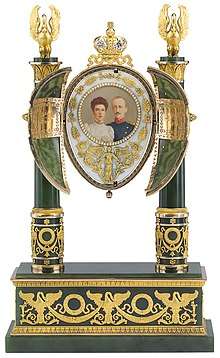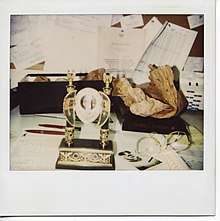Empire Nephrite (Fabergé egg)
The Empire Nephrite (sometimes mistakenly referred to as the Alexander III Medallion) egg is a jewelled Easter egg, one of the Imperial Eggs made under the supervision of the Russian jeweller Peter Carl Fabergé in 1901–1902 for Nicholas II of Russia, who presented it to his mother, the Dowager Empress Maria Feodorovna, at Easter 1902.
| Empire Nephrite Fabergé egg | |
|---|---|
 | |
| Year delivered | 1902 |
| Customer | Nicholas II |
| Recipient | Maria Feodorovna |
| Current owner | |
| Individual or institution | Private collection, New York, United States |
| Year of acquisition | Last known mid-1990s |
| Design and materials | |
| Workmaster | Mikhail Perkhin[1] |
| Materials used | Gold, silver, steel, enamel, nephrite, pearls, two brilliants (replacements) |
| Height | The egg 9,5 cm 3 6/8 in.; overall 21,5 cm (8 7/16 in.) |
| Width | The egg 6,3 cm (2 1/2 in.) diameter |
| Surprise | Miniature portrait of Grand Duchess Olga Alexandrovna of Russia and Duke Peter Alexandrovich of Oldenburg (original lost) |
History

The name of the egg refers to the fact that it was made in the Empire Style, from nephrite.[2] The original Fabergé invoice reads: "Egg, 'Empire', from nephrite, with gold, two diamonds and miniature". The egg reappeared in the mid-1990s and some Fabergé researchers were of the mistaken opinion that this egg featured a portrait medallion of Alexander III of Russia, though the original bill did not refer to a portrait of Alexander III.[3] This mistake was result of a misinterpretation of the Moscow Armory Chamber valuables selection list. This list noted an "Egg from nephrite, on a golden base, and with portrait of the Emperor Alexander III in a medallion".[4] Because of this, many researchers were certain that the 1902 Imperial egg featured an Alexander III portrait, though there is no evidence to support this.
However, in 2015, during research by a specially commissioned group of experts, a unique historical document was found – the "List of the personal property of the Dowager Empress Maria Feodorovna, located in storage at Gatchina Palace" by 28 July 1917. This 12-page booklet mentions at least 150 items, including 7 Imperial Fabergé eggs that belonged to the Dowager Empress Maria Feodorovna. On the second page of this document, as number 10, there is a description "Egg with gold mounts, on two nephrite columns, with portraits of Gr. Dss. Olga Alexandrovna and Duke P.A. Oldenburg inside". This description is the most accurate that Fabergé researchers have to date concerning the egg of 1902, which was previously mistaken for an "Egg from nephrite, on a gold base and with portrait of the Emperor Alexander III in a medallion".[5]
The egg is currently in a private collection in New York, USA.

See also
- Fabergé egg
- Egg decorating
- List of missing treasure
References
- Will Lowes; Christel Ludewig McCanless (2001). Fabergé Eggs: A Retrospective Encyclopedia. Scarecrow Press. p. 78. ISBN 978-0-8108-3946-5.
- 1902 Empire Nephrite Egg, Mieks Fabergé Eggs.
- Skurlov, Valentin; Faberge, Tatiana; Proper, Lynette G. (August 1997). The Faberge Imperial Easter Eggs. Christie's. p. 183. ISBN 090343248X.
- Tutova, Tatiana (2015). The Russian Imperial House court treasures destiny. The state historical-cultural museum-reserve "The Moscow Kremlin". p. 7. ISBN 978-5-88678-287-5.
- Tatiana Fabergé, Nikolai Bachmakov, Dmitry Krivoshey, Nicholas B.A. Nicholson (ed.), Valentin Skurlov, Anna Palmade, Vincent Palmade (2017). Faberge: The Imperial "Empire" Egg of 1902. New York: Harrison Piper & Co. pp. 14–15. ISBN 978-1-5323-4228-8.CS1 maint: multiple names: authors list (link)
External links
| Wikimedia Commons has media related to Empire Nephrite (Fabergé egg). |
- Tatiana Fabergé, Nikolai Bachmakov, Dmitry Krivoshey, Nicholas B.A. Nicholson (ed.), Valentin Skurlov, Anna Palmade, Vincent Palmade. Fabergé: The Imperial “Empire” Egg of 1902. — New York. — 2017. P. 364 ISBN 978-1-5323-4228-8
- (RU) Т. Фаберже, Н. Башмаков, Д. Кривошей (сост.), Н. Никольсон, А. и В. Палмейд, В. Скурлов. Фаберже. Императорское пасхальное яйцо «Ампир» 1902 года. М.: ООО «Буки Веди», 2018. 160 с. ISBN 978-5-4465-1824-1
- Mieks Fabergé Eggs